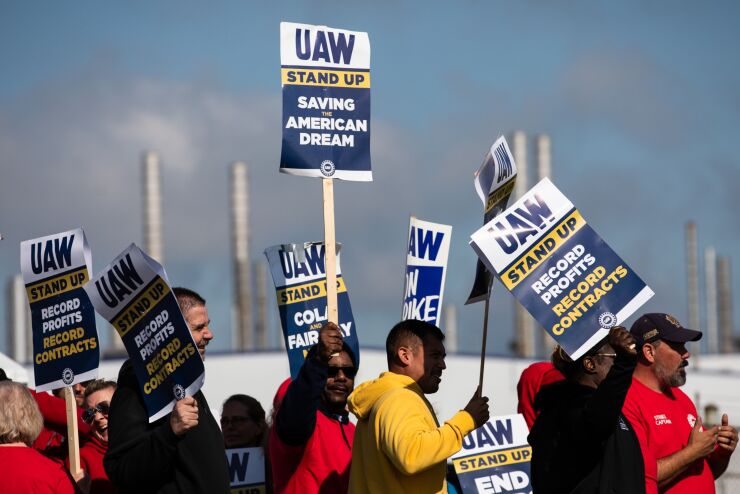
A prolonged strike at three of the country's largest vehicle manufacturers could lead to more inventory shortfalls for auto companies and a new roadblock for certain lenders, industry experts warned as the strike entered its first full week.
The idling of 12,700 workers at three U.S. assembly plants, coupled with the United Auto Workers' pledge to expand the strike if there is little progress in negotiations, could reduce the number of new vehicles on the market. Lower car production would put upward pressure on new-car prices, further weakening affordability and putting a portion of banks' auto lending revenue into question.
"If there aren't workers available to produce those vehicles, supply is going to go down," said Jill Louden, associate director of product management at S&P Global. "Ultimately, it's not a good thing for lenders or consumers."
The length of the strike will determine its ultimate impact on lenders that finance auto loans. A prolonged strike "is looking highly probable," S&P analysts said in a note Monday. When General Motors employees went on strike in 2019, the standoff lasted six weeks.
The strike adds an extra wrinkle to an auto market in which consumers are already facing higher sale prices and steeper annual percentage rates for both new and used vehicles. Auto lenders are raising minimum credit scores and otherwise upping lending requirements as they monitor consumers' financial health and the trajectory of the U.S. economy.
About 30% of consumers said they expect to be somewhat or much worse off a year from now, according to the Federal Reserve Bank of New York's survey of consumer expectations for August. That was up from 26% in July. In October, tens of millions of Americans will be required to resume payments on federal student loans, further stretching household budgets.
"It's a risky endeavor for lenders right now because you have so many other pressures on consumers, not just their auto loan," said Ivan Drury, director of insights at Edmunds. "There are mortgage payments or rent, and now student loans are coming back."
The auto workers' strike comes at a time when U.S. banks had started to report improvements in the supply-chain bottlenecks that previously limited the production of new cars.
"Auto loans are coming back strictly because supply has caught up," Dean Athanasia, Bank of America's president of regional banking, said at an industry conference last week.
Loans and leases in the Charlotte, North Carolina-based bank's vehicle lending segment totaled $55 billion in the second quarter, up from $51 billion a year earlier. Bank of America is among the banks with the most annual auto loan originations.
The lack of new vehicles available during the pandemic boosted demand for new cars, which led to higher prices. That required borrowers to take out bigger used-car loans, a boon for the lenders that finance those purchases.
At some lenders,
But auto dealers and lenders are no longer enjoying the benefits of record used-car prices. The Manheim Used Vehicle Value Index declined notably for four consecutive months before showing a slight increase in August.
In recent weeks, banks that offer auto loans have provided contrasting outlooks on the segment.
Earlier in 2023, Capital One Financial slowed originations of new auto loans because of lingering supply-chain issues and intense rate competition with other lenders, Chief Financial Officer Andrew Young said last week. But both of those challenges have started to fade in recent months, improving the McLean, Virginia-based company's forecast for its auto lending arm.
But several other lenders have
Wells Fargo, another top auto lender, said last week that it had stepped back a bit from the auto business over the past several quarters. The bank's chief financial officer, Michael Santomassimo, cited a potentially challenging economic environment and shrinking profit margins as reasons for the pullback.
Banks across the industry have been forced to pay depositors more as rates rise, making it more expensive for banks to fund a variety of consumer loans, analysts said.
"Funding pressures are definitely having an impact on how banks are thinking about extending credit," said Megan Fox, an analyst at Moody's Investors Service who covers U.S. banks and consumer lenders.
Rising interest rates are also making cars more expensive. Last month, the average APR on a new car loan was 7.4%, and the average amount of interest paid was $9,228, according to data from Edmunds. In August 2022, when the average APR was 5.7%, the average interest paid on a new vehicle was $7,413. Rates and interest paid on used-car loans have shown a similar trend.
High APRs make it easy for consumers' payments to snowball out of control quickly, Drury said.
"Many people don't even want to find out how much they're paying over time. They just look at the monthly payment and say, 'I can somehow manage this.' It's like ignorance is bliss," he said.
Polo Rocha contributed to this story.






